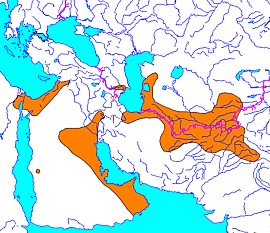|
 SCIENTIFIC
NAME: Otonycteris leucophaea (Severtzov, 1873) hemprichi
Peters, 1859 SCIENTIFIC
NAME: Otonycteris leucophaea (Severtzov, 1873) hemprichi
Peters, 1859
COMMON NAMES: Desert lpng-eared bat
DIMENSIONS: Body mass 17-30 g, head and body length 66-82 mm, tail
length is about 60 mm, forearm length 57-67 mm, wingspan 35-40 cm.
DESCRIPTION: Large vespertilionid bat. Ears large, about 40 mm in
length, not ajoin each other; tragus large, lancet shaped; facial
mask is naked, pinkish. Keel is not developed. Fur relatively thick
and long, almost white with yellowish, brownish or greyish tinges.
Wings are large and wide, with brounish-grey membranes. No small
upper premolars, number of incisors 1/3. Caryotype includes 30 chromosomes.
This bat was for decades treted as a synonim of O. hemprichi
Peters, 1859 (originally described from Egypt). However specific
distinctiveness of O. leucophaea was shown recently on the
basis of molecular and morphological data (Benda, Gvozdik, 2010).
DISTRIBUTION: From N. Iran, Tajikistan, Kyrgizstan, Turkmenistan,
Afghanistan, Pakistan and Kashmir. In mountain rich elevations up
to 2400 m ASL.
NATURAL HISTORY: Inhabits arid landscapes Use rock splits and human
buildings as day roosts. Foraging flight is low to the earth surface.
Feed on insects and small vertebrates; can hover over the prey and
take it from the substrate surface. Echolocation calls are low intensive,
sweep from ca. 40 to 18 kHz, with maximum energy at around 30-32
kHz. Natural history is poorly investigated. In summer females can
make nursing colonyes up to 60 individuals. Two newborns in litter,
reproduction is poorly known.
STATUS: Rare poorly investigated species. IUCN: "LR: lc".
|






